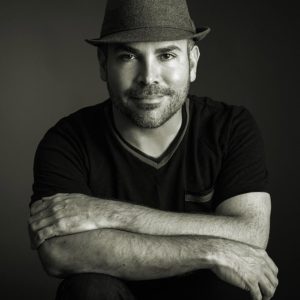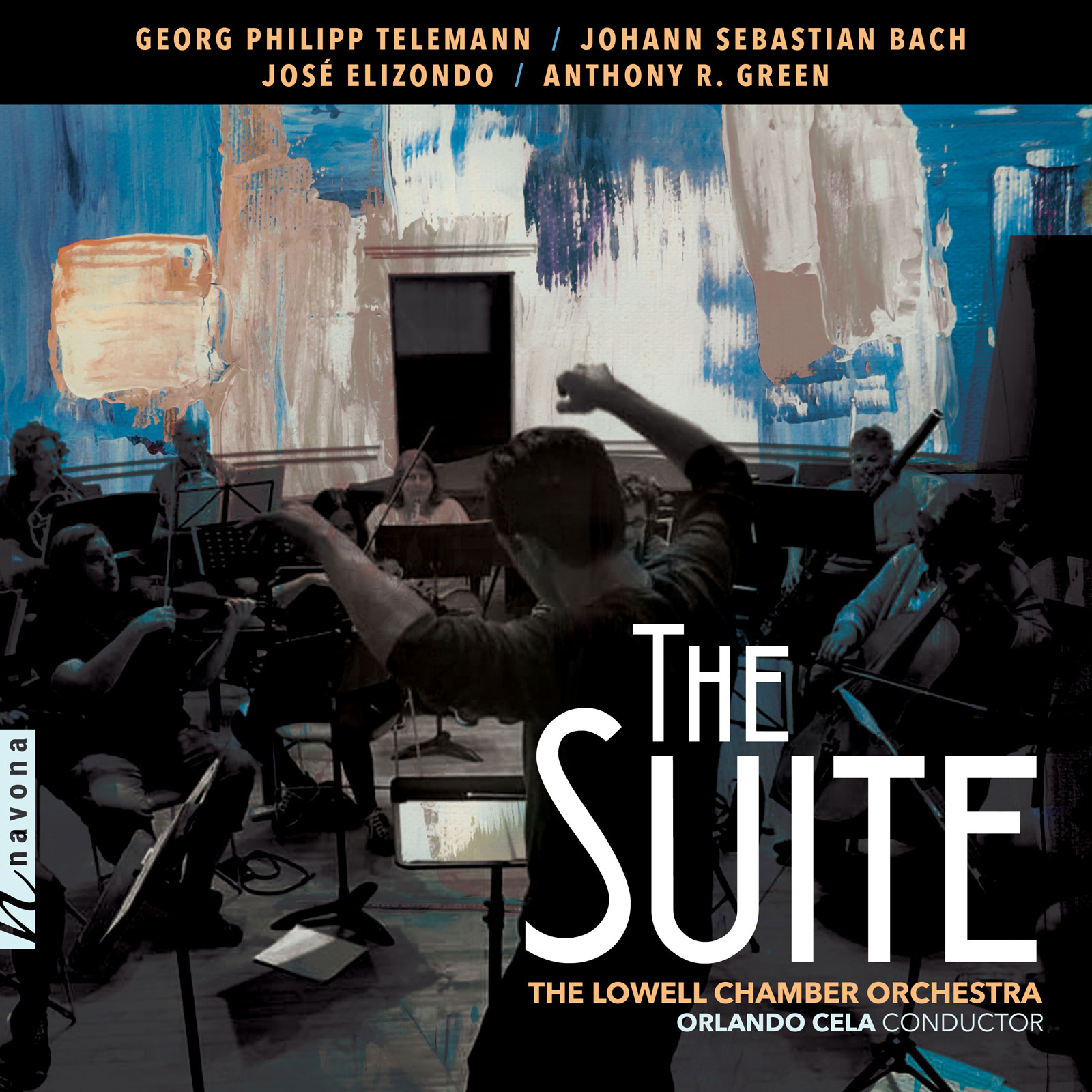The Suite
Georg Philipp Telemann composer
Johann Sebastian Bach composer
José Elizondo composer
Anthony R. Green composer
The Lowell Chamber Orchestra | Orlando Cela conductor
Though there are thousands of languages and countless political differences across the world, people tend to come together through equally endless forms of music and dance. On THE SUITE, the Lowell Chamber Orchestra, under the direction of Orlando Cela, focuses the lens on the Baroque dance suite as a method of expression that’s ripe for international flavor, artistic individualism, and human storytelling.
Suites by Georg Philipp Telemann and Johann Sebastian Bach examine the gallant style’s history and set the groundwork for modern interpretations. The Baroque vanguards pass the torch on to two contemporary composers, Anthony R. Green and Jose Elizondo, who shape and mold the style to match their own compositional artistry as they paint musical pictures of civil rights activism, heart-warming moments in the sun, and the passing of time.
What results is an alchemical combination of the old and the new that not only celebrates the original Baroque form, but expands upon it with contemporary, cross-cultural flair.
Listen
Stream/Buy
Choose your platform
"Cela and the Lowell Chamber Orchestra bring us a fresh view of where the Suite has been and something of where it seems to be going"
Track Listing & Credits
| # | Title | Composer | Performer | |
|---|---|---|---|---|
| 01 | Ouverture Suite in E Minor, TWV 55:e10: I. Ouverture | Georg Philipp Telemann (1681-1767) | The Lowell Chamber Orchestra | Orlando Cela, conductor | 5:44 |
| 02 | Overture Suite in E Minor, TWV 55:e10: II. Rigaudon | Georg Philipp Telemann (1681-1767) | The Lowell Chamber Orchestra | Orlando Cela, conductor | 2:36 |
| 03 | Overture Suite in E Minor, TWV 55:e10: III. Carillon | Georg Philipp Telemann (1681-1767) | The Lowell Chamber Orchestra | Orlando Cela, conductor | 2:12 |
| 04 | Overture Suite in E Minor, TWV 55:e10: IV. Air | Georg Philipp Telemann (1681-1767) | The Lowell Chamber Orchestra | Orlando Cela, conductor | 3:34 |
| 05 | Overture Suite in E Minor, TWV 55:e10: VI. Menuet I & II | Georg Philipp Telemann (1681-1767) | The Lowell Chamber Orchestra | Orlando Cela, conductor | 3:05 |
| 06 | Overture Suite in E Minor, TWV 55:e10: V. Gigue | Georg Philipp Telemann (1681-1767) | The Lowell Chamber Orchestra | Orlando Cela, conductor | 2:35 |
| 07 | Orchestral Suite No. 2 in B Minor, BWV 1067: I. Ouverture | Johann Sebastian Bach (1685-1750) | The Lowell Chamber Orchestra | Orlando Cela, conductor | 7:04 |
| 08 | Orchestral Suite No. 2 in B Minor, BWV 1067: II. Rondeau | Johann Sebastian Bach (1685-1750) | The Lowell Chamber Orchestra | Orlando Cela, conductor | 1:59 |
| 09 | Orchestral Suite No. 2 in B Minor, BWV 1067: III. Sarabande | Johann Sebastian Bach (1685-1750) | The Lowell Chamber Orchestra | Orlando Cela, conductor | 2:11 |
| 10 | Orchestral Suite No. 2 in B Minor, BWV 1067: IV. Bourrées I & II | Johann Sebastian Bach (1685-1750) | The Lowell Chamber Orchestra | Orlando Cela, conductor | 1:58 |
| 11 | Orchestral Suite No. 2 in B Minor, BWV 1067: V. Polonaise & Double | Johann Sebastian Bach (1685-1750) | The Lowell Chamber Orchestra | Orlando Cela, conductor | 3:45 |
| 12 | Orchestral Suite No. 2 in B Minor, BWV 1067: VI. Menuett | Johann Sebastian Bach (1685-1750) | The Lowell Chamber Orchestra | Orlando Cela, conductor | 1:31 |
| 13 | Orchestral Suite No. 2 in B Minor, BWV 1067: VII. Badinerie | Johann Sebastian Bach (1685-1750) | The Lowell Chamber Orchestra | Orlando Cela, conductor | 1:29 |
| 14 | Recuerdos estivos: I. Limoncello | José Elizondo | The Lowell Chamber Orchestra | Orlando Cela, conductor | 3:48 |
| 15 | Recuerdos estivos: II. Crepúsculos Alpinos | José Elizondo | The Lowell Chamber Orchestra | Orlando Cela, conductor | 4:39 |
| 16 | Recuerdos estivos: III. Despapaye | José Elizondo | The Lowell Chamber Orchestra | Orlando Cela, conductor | 4:04 |
| 17 | The Green Double: I. Protest Dancing | Anthony R. Green | The Lowell Chamber Orchestra | Orlando Cela, conductor | 3:40 |
| 18 | The Green Double: II. Dance Reflections | Anthony R. Green | The Lowell Chamber Orchestra | Orlando Cela, conductor | 4:29 |
| 19 | The Green Double: III. A Little Lite Music | Anthony R. Green | The Lowell Chamber Orchestra | Orlando Cela, conductor | 11:28 |
FLUTE
Orlando Cela 1-19
Wei Zhao 17-19
VIOLIN
Peter Sulski 1-19
Susanne Powers 14-16
Karen McConomy 1-19
Yen-Chun Angela Wang 1-16
Katharina Radlberger 14-19
Maureen Taranto-Pyatt 4-9
Shek Wan Li 7-13
VIOLA
Jessica Cooper 14-19
Jing Peng 1-16
Alex Vavilov 1-6
BASS
Steve Skop 17-19
John Dowd 1-16
CELLO
Ariana Falk 17-19, 1-6
Leo Eguchi, Naomi Steckman 14-16
Aron Zelkowicz 7-13
PIANO, HARPSICHORD
Yukiko Shimazaki 1-16
Recorded 2019 – 2020 at Futura Productions in Roslindale MA
Session Engineer John Weston
Executive Director of the LCO Em Russell
The Lowell Chamber Orchestra is supported by the Greater Lowell Community Foundation.
Executive Producer Bob Lord
Executive A&R Sam Renshaw
A&R Director Brandon MacNeil
VP, Audio Production Jeff LeRoy
Audio Director Lucas Paquette
Mastering Shaun Michaud
VP, Design & Marketing Brett Picknell
Art Director Ryan Harrison
Design Edward A. Fleming
Publicity Patrick Niland, Sara Warner
Artist Information

The Lowell Chamber Orchestra
The Lowell Chamber Orchestra is Lowell’s first and only professional orchestra, providing the area with an ensemble that presents music at a very high level, of all styles and time periods, entirely free to the general population. Now in its third season, the LCO has presented concerts that encompass established orchestral repertoire as well as multimedia works, stage works, lecture-presentations, and chamber music. As part of its mission of promoting, preserving, and educating, the repertoire includes works from the Baroque to current commissions.

José Elizondo
Mexican composer José Elizondo received degrees in Humanities, Electrical Engineering and Computer Science from the Massachusetts Institute of Technology (MIT). At Harvard University, he studied musical analysis, orchestration and conducting. As an engineer, Elizondo’s work focuses on speech-recognition technology, which combines his interests in computer science, linguistics, natural language processing and artificial intelligence.

Anthony R. Green
The creative output of ANTHONY R. GREEN (composer, performer, social justice) includes musical and visual creations, interpretations of original and repertoire works, collaborations, educational outreach, and more. Behind all his artistic endeavors are the ideals of equality and freedom, which manifest themselves in diverse ways in a composition, a performance, a collaboration, or social justice artistic work.
Notes
Dancing has always been a natural human response to music. And with their specific traits, dances are important symbols of identity and culture. Composers have long stylized these dances to bring not only the idiosyncrasies of far away lands without leaving the concert hall. Some of them represent our very own land, while some represent foreign landscapes and languages. All of the composers on this album have written dances in their very own styles, and while they are very different from each other, they are effective in communicating cultures and experiences, old and new, far and near.
Thanks to everyone who has supported the Lowell Chamber Orchestra since before its inception: the donors, performers, composers, partners, and everyone who helped us get off the ground and help us to keep going. Thanks to Em Russell for the hard work she does behind the scenes. Thanks to you for listening, and for going beyond these tracks and hearing more music by our two wonderful living composers, featured here. And finally, and most importantly, thanks to my parents for all the support that they have always given me through my musical life. This album is dedicated to the memory of Angel Cardiel whose love for music was inevitably contagious.


